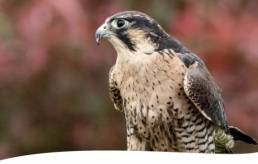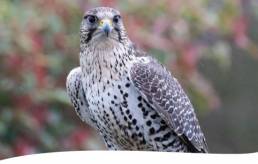Falcons
There are around 40 different species of Falcon spanning every continent of the world except Antarctica.
The Peregrine Falcon is the fastest creature on the planet reaching speeds of 200mph when swooping towards prey! Falcons were traditionally used for hunting as a means of catching prey for the table and despite being thousands of years old the art of falconry is still in practice today. Our Falcon family is made up of four species, from the powerful Gyr/Saker Falcon to the unmistakable British ‘Common Kestrel’. During our live shows (and routine exercises for the Falcons) – we swing the lure to show spectators just how powerful and fast this species really are. It’s an amazing sight to see!

Lanner Falcon
The male Lanner is called a ‘Lanneret’.
LATIN NAME: Falco biarmicus
DISTRIBUTION: South Europe, Middle East, South West Asia, Africa
HABITAT: Varied – open dry country, semi-desert, grassland
DIET: Mainly small to medium sized birds, small mammals, reptiles, insects
WINGSPAN: 88–113cm

Common Kestrel
Kestrels have the ability to see in the ultraviolet light spectrum. This helps them find their prey, by allowing them to spot and track their prey’s urine!
LATIN NAME: Falco tinnunculus
DISTRIBUTION: Europe, Africa, Asia
HABITAT: Wide ranging
DIET: Mainly small mammals, small birds, reptiles, insects
WINGSPAN: 55–80cm

Peregrine Falcon
LATIN NAME: Falco peregrinus
DISTRIBUTION: It can be found nearly everywhere from tundra to deserts, apart from Antartica
HABITAT: Wide-open spaces, and thrive near coasts where shorebirds are common
DIET: Feeds almost exclusively on medium-sized birds such as pigeons and doves, waterfowl, songbirds, and waders
WINGSPAN: 74–120cm

Gyr Saker Lanner
Nikki is a hybrid falcon, who was bred for the Arab market. You won’t find this falcon in the wild, due to the individual types never co-existing in the same parts of the world.

